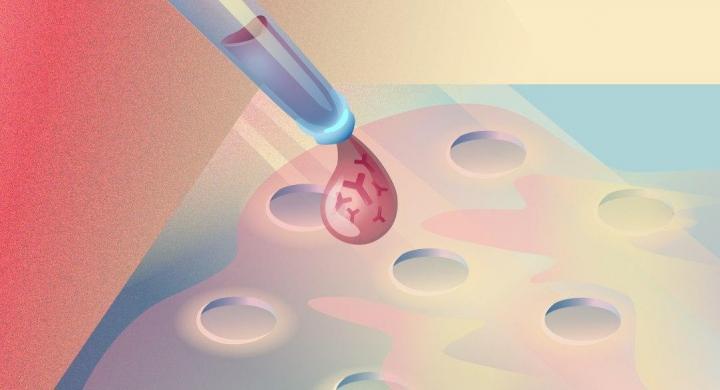
Credit: Daria Sokol/MIPT Press Office
Researchers from Prokhorov General Physics Institute of the Russian Academy of Sciences and the Moscow Institute of Physics and Technology have developed a novel method for diagnosing and monitoring autoimmune disorders. Within a mere 25 minutes, their new biosensor not only measures the concentration of autoantibodies in human blood serum with extremely high sensitivity, but also — for the first time — quantifies their activity. The combination of these parameters permits the elaboration of new diagnostic criteria for autoimmune diseases, as well as new approaches to their treatment. The paper was published in Biosensors and Bioelectronics, the highest-ranking scientific journal in the field of biosensing technology and analytical chemistry.
Autoantibodies produced by the immune system misinterpret the organism’s cells and organs as targets, causing autoimmune disorders. The autoantibodies are associated with more than 80 serious autoimmune diseases ranging from rheumatoid arthritis, psoriasis, and lupus to multiple sclerosis and Type 1 diabetes. Many of them require lifelong care and treatment to alleviate suffering. Autoantibodies are present in the blood of about 10% of the population. Due to a high prevalence of autoimmune disorders, the economic impact is enormous and is estimated for some countries as twice that of cancer. Autoantibodies appear in blood long before clinical onset, and their characteristics can be used to foresee disease activity and severity.
Currently, the treatment of autoimmune diseases is substantially complicated due to dramatic variations in the results of commercial tests by different manufacturers.
“Depending on the laboratory running the test, and the method used, the autoantibody concentration measured in the same sample at the same time may vary by a factor of 10,” says one of the paper’s authors Alexey Orlov, a senior scientist of the Biophotonics Lab at GPI RAS and Nanobiotechnology Lab at MIPT, a 2010 graduate of MIPT. “In fact, no one could rely on autoantibody concentration as a quantitative parameter to evaluate therapy efficiency.”
Such inconsistencies in test results stem from the complex nature of autoantibodies. An autoantibody comprises a set of many heterogeneous molecules that interact with each other and with a target in substantially different ways. Until now, no technique has provided the capacity to account for this factor.
Also, the existing methods, widely used in the clinical practice, do not provide the option to characterize antibody activity — the parameter that shows how destructive the antibodies are to target tissues. The authors have developed a tool that addresses both issues at once: It performs rapid high-sensitivity measurements of autoantibody activity and concentration.
Another innovative feature is the simultaneous determination in a single sample of the concentration and activity of autoantibodies to several targets. Such approach substantially increases the diagnostic merit of the solution because different levels of autoantibodies to dissimilar targets may be indicative of distinct diseases. A correlation analysis of the data concurrently obtained on multiple autoantibodies can considerably enhance the accuracy of diagnostics.
“That is why we call our system multiplex, or multiparametric,” mentions study co-author Averyan Pushkarev, an MIPT doctoral student and 2018 alumnus. “One strong advantage is the consumables used in our technique: We use a standard microscope cover glass. Its low cost is especially important for mass medical diagnostics, which requires disposable consumables.”
While the study demonstrates the simultaneous characterization of antibodies to two targets, the team is working on increasing that number. Using the microchip technology, for example, thousands of 100-micron-sized targets can be deposited on a glass slip.
In the new technique, a drop of patient blood serum is passed over the glass slip surface. If antibodies are present in the serum, they find their targets deposited on the glass and bind to them, increasing the biolayer thickness on the glass. Under the glass slip, there is an interferometry system developed at GPI RAS. This unique optical reader enables real-time measurements of the thickness of the molecular layer in each spot on the glass surface.
“A fundamentally important detail: Unlike a multitude of other methods, we have the autoantibodies interact with moving targets rather than those immobilized on a surface,” Orlov adds. “This is the first-ever solution that allows the investigation of autoantibody interaction with targets in their natural form and environment, as they are present in a living organism.”
This is achieved as follows (fig. 1). Once an autoantibody binds to a target on the glass, the researchers pump a solution of free target molecules along the glass. At that point, the authors implement an approach that no one has been able to put into practice for the mentioned important task. Each autoantibody possesses one or more recognition fragments, known as Fab-fragments or “hands,” which can recognize and grab targets. In the test, an autoantibody grabs the immobilized target with one “hand” and uses the others to catch mobile targets from the serum sample. This process delivers quantitative data on the actual (native) activity of antibodies. Moreover, this setup, on the one hand, provides autoantibody immobilization on the glass in their natural form, and on the other hand, minimizes the binding of foreign components that may affect the results.
“We have developed not only an efficient diagnostic test but also a unique tool for the investigation of autoantibodies,” comments the paper’s senior author Petr Nikitin, who heads the Biophotonics Lab at GPI RAS and is a 1979 graduate of MIPT. “Using patient blood samples, we have demonstrated that the quantitative parameter of autoantibody activity is independent of their concentration. The clinicians now have a tool for quantitatively monitoring both key parameters in the course of a disease, and elaborating novel advanced methods for the diagnostics and treatment of autoimmune disorders.”
###
The study was supported by the Russian Science Foundation.
Media Contact
Varvara Bogomolova
[email protected]
Original Source
https:/
Related Journal Article
http://dx.




